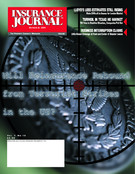Time and distance have a way of muting the painful impact of horrifying events and focusing attention on the practical matters of coping with the aftermath. The Sept. 11 tragedies are no exception. And while we are barely able to come to grips with the recent violence, one aspect of that aftermath to consider is: what happens if there is another financially devastating attack or catastrophe?
Last week several Wharton Business School professors and insurance experts took a look at this question and other aspects of the Sept. 11 attacks.
Will insurers be able to pay for the “next big hit,” even if they are able to pay for the present catastrophe? If the cost of the attacks turns out to be $30 billion or $40 billion, as analysts and others predict, the professors agree the industry can cope.
But the attacks will dramatically change the way the industry views risk, believes Paul Kleindorfer, professor of decision sciences, economics, and business and public policy. The idea of four airplanes crashing in the space of a couple of hours was not built into their scenarios. Another professor suggests government-sponsored, reasonably-priced (not subsidized) reinsurance contracts that insurers could buy, describing a not-yet-enacted concept known as Catastrophic Excess of Loss (or XOL) reinsurance.
“This attack raises the question, is this a commercially insurable risk?” asks Jerry Rosenbloom, professor of insurance and risk management. “How do you know what to charge if the magnitude of losses is so great and unpredictable? For the real super-catastrophe, we may need a combination of private insurance companies, the government and maybe the capital markets.”
Warren Buffett, Berkshire Hathaway, has already argued in favor of a strong role for the government. The Wall Street Journal quoted him as saying, “the government is going to have to be the ultimate insurer for acts of terrorism. An industry with very large, but finite, resources is not equipped to handle infinite losses.”
Rosenbloom believes that insurance companies will place greater stress on prevention and security. “It may be much like the way earthquakes are treated: you’ll need buildings built a certain way, prevention devices and alarms. We will see all kinds of new requirements before an insurance company will write the risk.”
What’s the prognosis? Liquidity will be a challenge, and some smaller insurers might disappear. If loss estimates stay below $40 billion though, we should be able to weather this storm. But what of the next? In 1992, natural disasters cost $32 billion worldwide. The attack makes 2001 a terrible year already. The industry, like the U.S. itself, needs to begin serious preparations for the unthinkable.
Final Editor’s Note: Although this is my last column as managing editor of IJ Texas, I will remain on the insurance scene in Texas as director of information services for the IIAT. Stephanie K. Jones has been named managing editor of the magazine and assumes control with the next issue.
Best wishes
Topics Carriers
Was this article valuable?
Here are more articles you may enjoy.


 ‘Great Resignation’ Enters Third Year as Workers Embrace AI, Upskilling, PwC Says
‘Great Resignation’ Enters Third Year as Workers Embrace AI, Upskilling, PwC Says  Home Insurance at $10,000 a Year Shows California Buyers’ Pain
Home Insurance at $10,000 a Year Shows California Buyers’ Pain  Workers Sue Disney, Say They Were Wrongly Induced to Move to Florida
Workers Sue Disney, Say They Were Wrongly Induced to Move to Florida  BlackSuit Cybercrime Gang Blamed in CDK Hack That Roiled Car Dealers
BlackSuit Cybercrime Gang Blamed in CDK Hack That Roiled Car Dealers 


